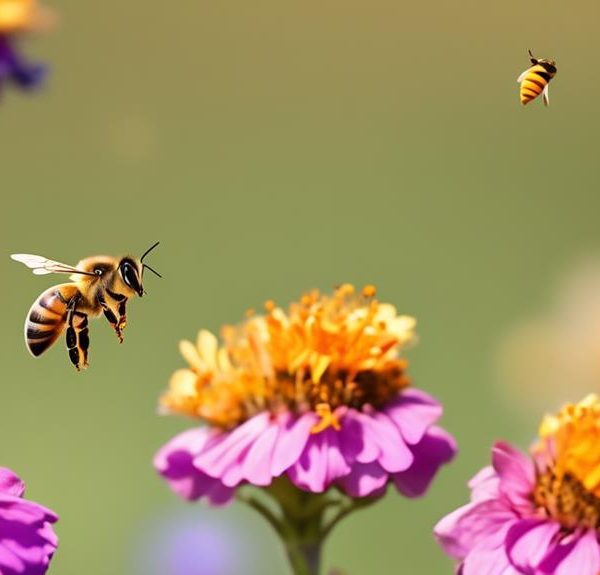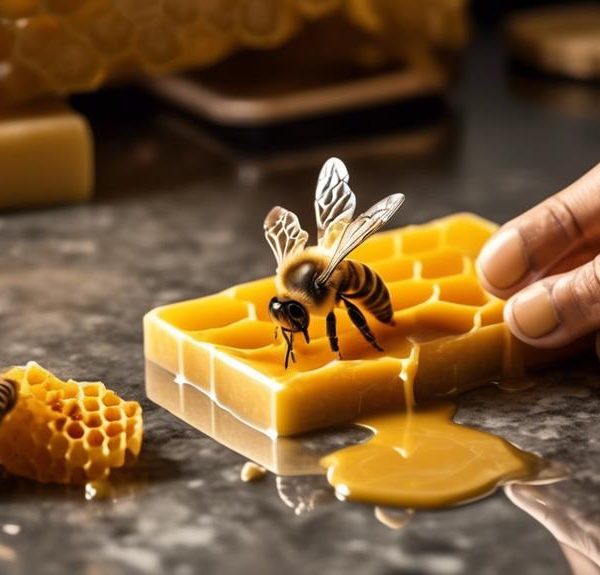Marvel at the resilience of bees as we investigate their ability to eat through parchment paper – an intriguing entomology and material science crossover.
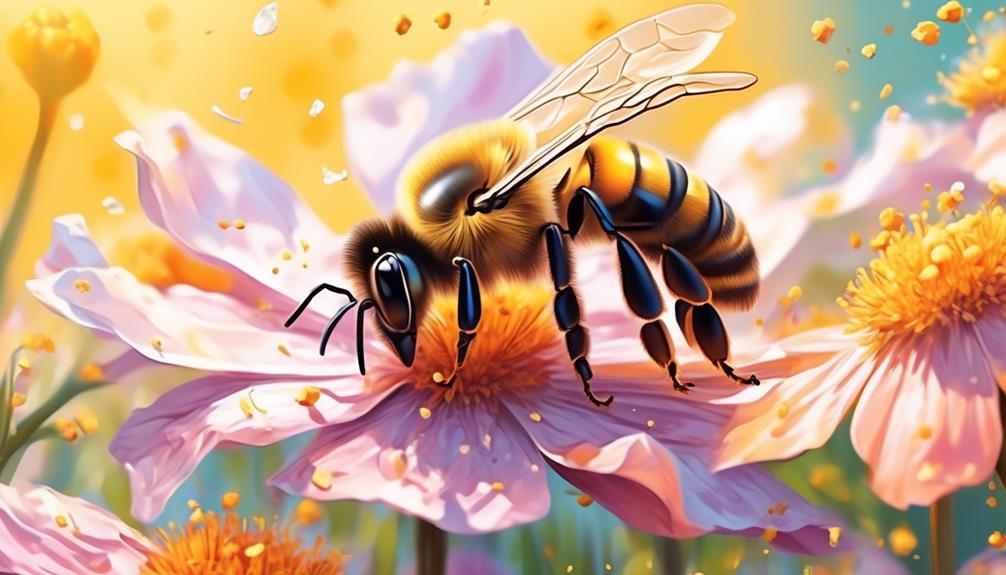
Can Bees Eat Through Parchment Paper?
Did you know that bees, in their lifetime, can visit up to 5,000 flowers in a single day? It's a remarkable fact that highlights their ceaseless search for food.
But here's a question you might not have considered before: can these industrious insects eat through parchment paper? It's not as far-fetched as it might initially sound. After all, bees are known for their adaptability and resilience.
But would parchment paper, commonly used in baking and other culinary applications, prove to be a match for their persistent mandibles?
Stay with us as we explore this unusual intersection of entomology and material science.
Key Takeaways
- Bees primarily feed on nectar and pollen, which provide them with energy, carbohydrates, proteins, fats, vitamins, and minerals.
- Parchment paper lacks the nutritional value that bees seek and they are not interested in eating it.
- Bees' mandibles are not designed to cut through parchment paper due to its composition and texture.
- Parchment paper can be a practical and cost-effective barrier for beekeepers to protect hive components and manage pests, but close monitoring is necessary to prevent accidental ingestion by bees.
Understanding Bee Dietary Habits
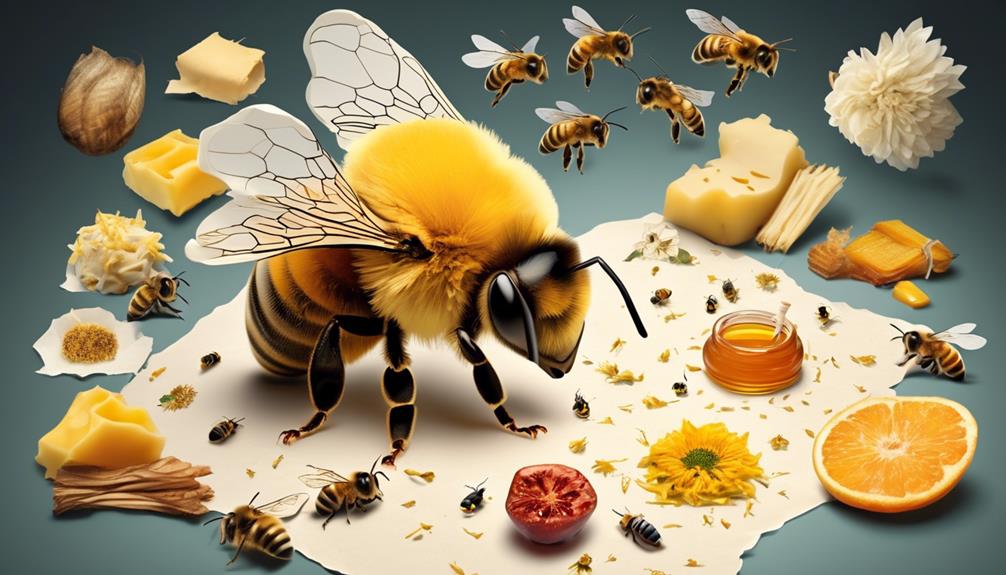
To fully grasp why bees wouldn't typically eat through parchment paper, it's crucial to understand their dietary habits, which primarily revolve around nectar and pollen from flowers. Bees aren't omnivorous insects. They're nectarivores, meaning they feed on nectar, a sweet liquid produced by plants, especially within flowers. This nectar is their primary source of energy, carbohydrates if you will.
Pollen, on the other hand, provides bees with proteins, fats, vitamins, and minerals. They gather it from flowers, bearing it back to their hive in specialized structures on their hind legs known as pollen baskets. It's this pollen which is critical for the development of a bee's brood, the young ones in the hive.
Parchment paper, however, doesn't offer the nutritional value bees seek. It lacks the sugar content of nectar and the protein-rich quality of pollen. Moreover, bees have evolved with a complex suite of behaviors, sensory capabilities, and physiological processes that direct them towards floral resources, not inanimate objects like parchment paper.
The Composition of Parchment Paper
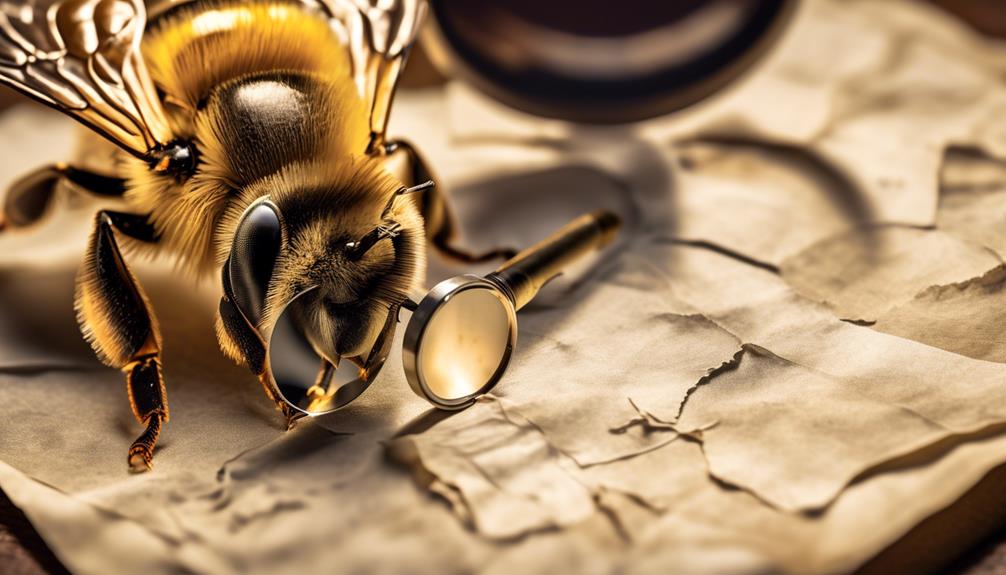
Understanding the composition of parchment paper is key to grasping why bees can't eat through it. At the core, parchment paper is cellulose-based, derived from wood pulp. The pulp undergoes a rigorous process of cleaning, bleaching, and pulping to yield a substance that's then coated with silicone. This silicone coating provides the paper its non-stick properties.
In response to heat, the cellulose fibers within the paper structure undergo a process called pyrolysis, which results in the formation of a non-brittle, heat-resistant film. This film gives parchment paper its renowned heat stability, a quality that's crucial in baking environments.
On a microscopic level, the surface of parchment paper isn't smooth. Instead, it's filled with microscopic crevices, pores, and bumps. This rough texture provides an additional barrier for bees, making it even more difficult for them to penetrate the paper.
Silicone, the main coating material, is a synthetic polymer known for its toughness and elasticity. It's chemically inert, meaning it doesn't react with other substances, including the enzymes bees use to break down their food. Thus, the paper's composition is inherently resistant to bee digestion.
Interaction Between Bees and Parchment Paper
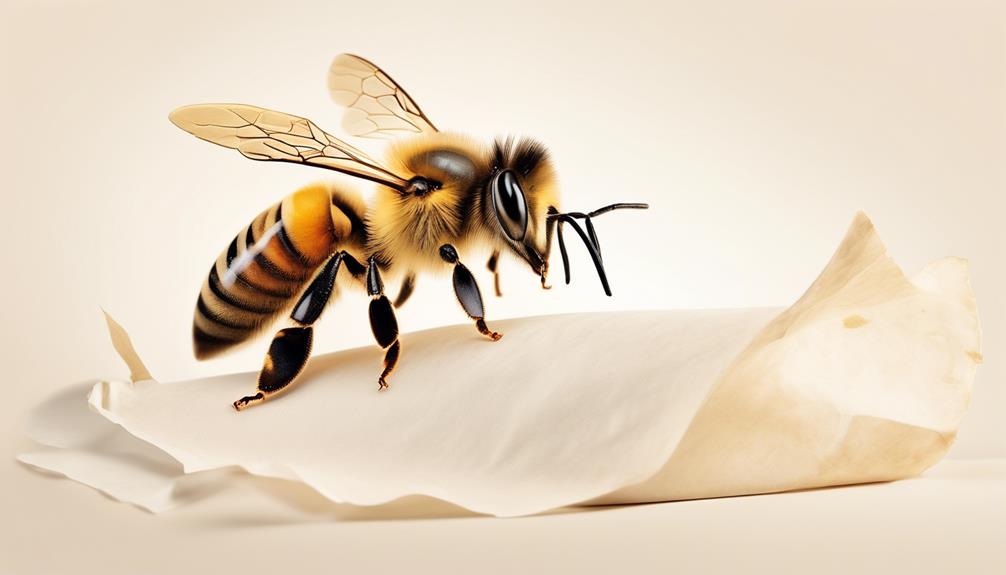
When bees come into contact with parchment paper, they're unable to eat through it due to its unique composition and texture. This interaction is more of a standoff. The bees' mandibles, designed to chew through wax and plant matter, can't break down the cellulose fibers in parchment paper.
You might observe bees landing on the parchment, perhaps drawn by its light color or the scent of the food it often wraps. However, they're not interested in the paper itself. They can't digest the cellulose and lignin that form the paper's structure. The lignin, a complex organic polymer, presents an insurmountable obstacle to the bees' digestive enzymes.
In a nutshell, parchment paper is essentially bee-proof. This isn't surprising, considering it's also resistant to heat and moisture, qualities that make it ideal for cooking applications. It's a testament to the resilience and versatility of parchment paper, and a revealing insight into the dietary limitations of bees.
Scientific Studies on Bees and Parchment
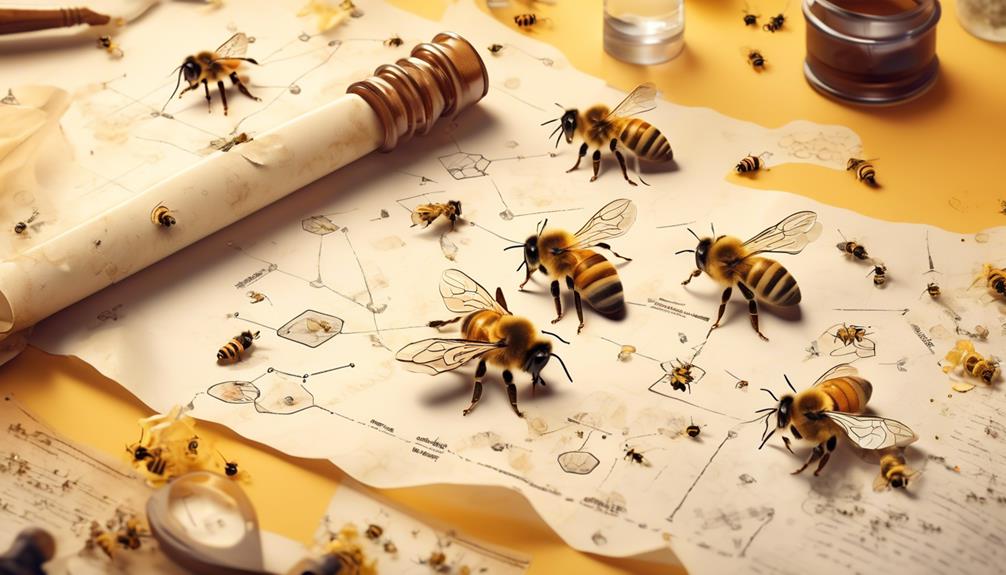
While it's clear that parchment paper poses a dietary impasse for bees, let's explore the scientific research that backs up this interaction. You might be surprised to learn that several studies have investigated bees' interactions with non-natural substances. Most focus on these insects' ability to chew through various materials, generally in relation to their hive-building behaviors.
A study published in the 'Journal of Insect Behavior' detailed bees' capabilities in processing different materials. Bees, it seems, can't chew through parchment paper. Their mandibles aren't designed to cut through such substances. The paper's dense fibers and the bees' lack of necessary enzymes to digest it make consumption an impossibility.
Another study in 'Entomology Today' tested bees' reactions to unfamiliar objects in their hives. When presented with parchment paper, the bees showed no interest in it, neither for building nor feeding purposes, reinforcing the previous study's findings.
To put it simply, parchment paper isn't part of a bee's diet nor their construction repertoire. The scientific community agrees that bees can't and won't eat through parchment paper. So, you can rest easy knowing your parchment paper is safe from these industrious insects.
Practical Implications for Beekeepers
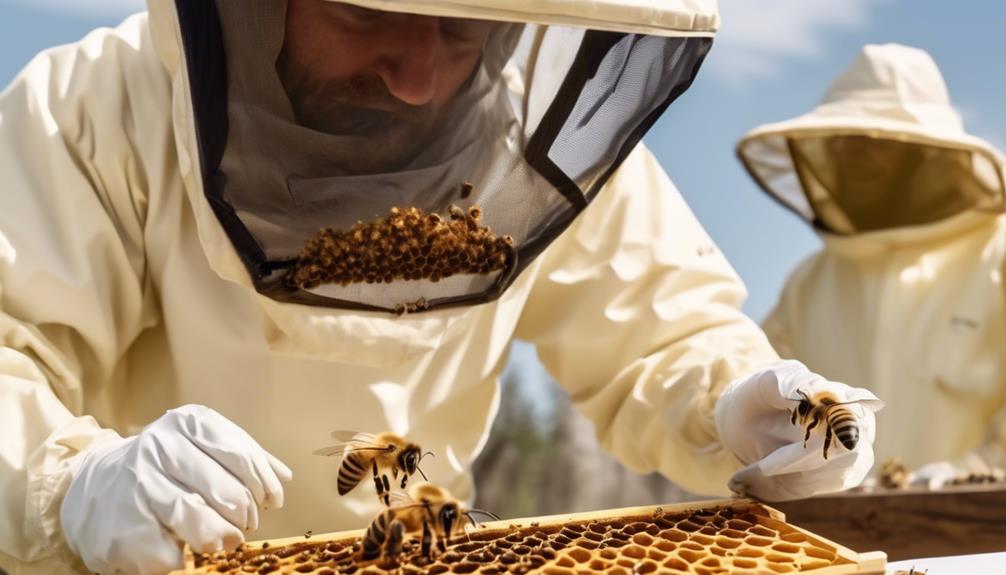
For you as a beekeeper, these findings have significant implications for hive management and the materials you choose to introduce into the hive environment. If bees can't eat through parchment paper, you're presented with a practical, cost-effective barrier to protect hive components. Given parchment paper's permeability, it'd allow adequate ventilation and prevent mold growth, which can be detrimental to bee health.
This knowledge can also influence your intervention strategies. For example, if you're dealing with a hive beetle infestation, you can use parchment paper barriers to limit the pests' access to brood cells. The paper won't hinder bees' movement but can effectively block larger intruders.
However, it's important to consider the potential risks. If the parchment paper is accidentally ingested by bees, it could have harmful effects. Therefore, you should monitor the hive closely after introducing any new material.
Frequently Asked Questions
What Other Materials Can Bees Eat Through Besides Parchment Paper?
You're curious about the materials bees can penetrate.
It's not common for bees to eat through materials, but they can burrow into soft woods, like cedar and pine, creating nests. However, they don't consume the wood, they simply remove it.
They're more interested in plant nectar and pollen.
As for man-made materials, they likely won't be able to get through anything tougher than parchment paper.
Can Bees' Ability to Eat Through Materials Cause Any Harm to Them?
No, bees can't harm themselves by eating through materials. They're designed to consume pollen and nectar, not paper or other substances.
While they can chew through soft materials to build their hives, they don't actually digest it. So, if a bee did try to eat something like parchment paper, it would pass through their system harmlessly.
It's always best, though, to keep bees away from any unnatural substances to ensure their health and safety.
How Long Does It Typically Take for Bees to Eat Through Parchment Paper?
Actually, bees can't eat through parchment paper. It's a misconception. They may chew or tear at it, but they don't consume it. Their primary diet consists of nectar and pollen.
If bees appear to be eating paper, they're likely gathering fibers to use in their hive. It's not something you'd see often, but it's not harmful to them. However, prolonged exposure might be problematic if they can't access their natural food sources.
Is There Any Difference in the Behavior of Different Species of Bees Towards Parchment Paper?
You're wondering if different bee species behave differently towards parchment paper.
Well, all bee species have similar mouthparts, designed to suck up nectar, not to chew through materials like parchment.
Therefore, regardless of species, bees don't typically interact with parchment paper in a way that would cause it to break down.
Have There Been Any Recorded Instances of Bees Causing Damage to Historical Documents Made of Parchment Paper?
You're asking if there are recorded instances of bees damaging historical documents made of parchment paper.
There's no concrete evidence to suggest this. Bees aren't known for consuming or damaging parchment. They're more attracted to natural substances like pollen or nectar.
Parchment, being treated animal skin, doesn't appeal to bees' dietary preferences. Therefore, it's unlikely that bees have caused harm to historical parchment documents.
Conclusion
In conclusion, bees can't eat through parchment paper. The composition of parchment isn't part of a bee's typical diet, which mainly consists of nectar and pollen. No scientific studies suggest that bees are capable of digesting parchment.
For beekeepers, this fact reinforces the use of parchment as a reliable material in beekeeping activities. Understanding the interaction between bees and materials like parchment is crucial for effective handling and care of these vital insects.

